Did you know that only emperors, kings, and presidents had the privilege to enjoy ice cream long before it became available to the masses? With a rich and fascinating history, ice cream is one of the oldest and most beloved desserts in the world. This pudding is made from sweetened milk and includes chocolate, vanilla, or fruits, such as strawberries. But it is more than that. Ice cream is essential for happiness, as it satisfies your sweet tooth, cools you down, lifts your mood, and even heals the wounds in a broken heart. This is why we pay tribute to such an amazing delicacy and explores its origins from ancient times to modern days.
“I’d rather have ice cream than a psychiatrist.”
Marilyn Monroe

Today’s Focus of Attention is reader-supported. We sometimes include products we think are useful for our readers. If you buy through links on this page, we may earn a small commission.
Ice: The First Source of Frozen Desserts
The oldest natural base for any chilled sweet is ice. For thousands of years, humans have been using it along with snow to create sweet treats, according to archaeological and historical evidence from various regions of the world.
Human Evolution and Traditions
Ice and snow played an important role in human expansion, culture, and migration. Researchers suggest that eating icy shards helped early humans survive the Ice Age, providing hydration and thermoregulation. Those frozen crystals also inspired myths and rituals in different cultures, such as the Norse mythology of the frost giant Ymir, or the Japanese practice of making snow rabbits.
Ancient Ice Cream Recipes
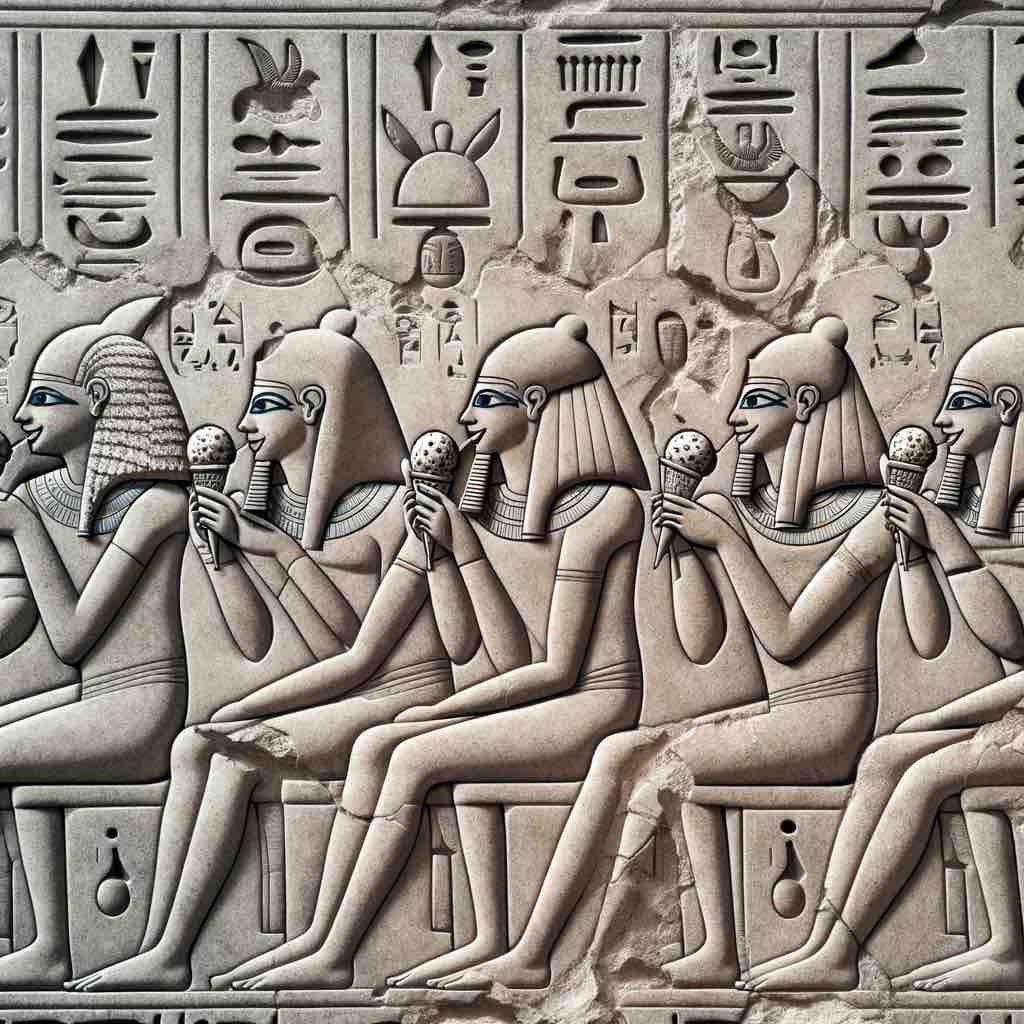
Mesopotamia
The earliest evidence of using ice and snow for cold treats dates back to the 2nd millennium BC.
Mesopotamians collected snow from the mountains and stored it in underground chambers named ‘yakhchals,’ an archaic type of evaporative cooler that could store frozen water gathered during the winter months.
They used snow to make a drink called ‘sharbat,’ which consisted of fruit juice, honey, and spices. ‘Sharbat’ is the origin of the word ‘sherbet,’ which later became ‘sorbet’ in English.
Persia
As early as 550 BC, Persians were creating ice cream-like foods using ice houses and ice pools, allowing them to serve and produce ‘faloodeh’ and sorbets throughout the year.
As in Mesopotamia, this was possible because of the ‘yakhchal.’
Egypt, Greece, and Rome
The Egyptians, Greeks, and Romans likewise got those chilly flakes from natural sources such as rivers, lakes, or mountains, as well as from ice houses or pools
In the same way as the Mesopotamians, they prepared refreshing drinks with fruit and honey, but the Romans improved them by creating desserts with wine or milk.
China
During the Tang dynasty (618–907 AD), the Chinese developed a method to produce a cold nectar using flour, camphor, water, and buffalo milk.
This innovation could very well be a precursor to what we understand as ice cream today.
Emulating the Winter’s Tears
The first devices for making ice were invented in China around the 7th century AD. Those instruments comprised metal or ceramic vessels filled with water and placed in a mixture of saltpetre, ice, and water.
The saltpetre caused the water to freeze at a lower temperature, and when the ice absorbed the water’s heat, it formed crystals in the containers.
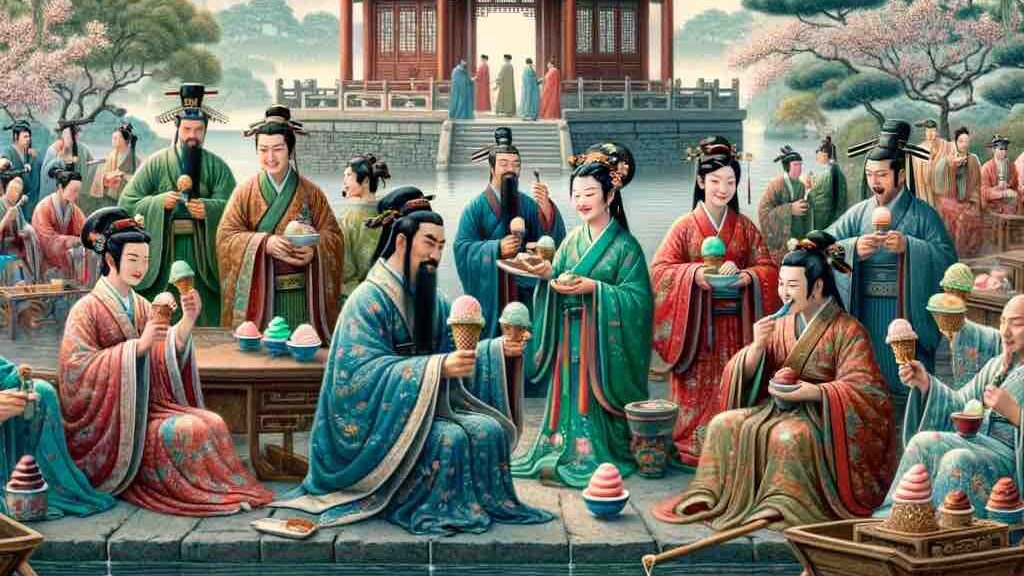
Innovations
After the conquest of the Persian Empire around 632 AD, Arabs adapted the syrup-laced treat ‘sharbat’ by adding dairy, leading to an early version of today’s ice cream. And, like the Chinese, they discovered the use of rock salt mixed with ice to freeze liquids.
On the other side of Asia, Japanese created the “Kakigori,” a pudding made with ice and syrup. It dates back to the Heian period, when blocks of ice were saved in the winter to serve desserts to the aristocracy during the summer.

Europe
Marco Polo introduced frozen treats from China to Italy in the 13th century, shaping European cuisine and setting the stage for refreshing puddings.
Each culture’s unique approach to harnessing the cooling properties of frost has contributed to the rich history of icy sweets.
Sherbet: The Next Step in Frozen Delight
A significant milestone in the development of chilly treats was the creation of ‘sherbet.’ It serves as a bridge between the ice and snow concoctions and the more sophisticated blends that followed.
What is Sherbet?
Sherbet is a cool dessert that consists of fruit juice, sugar, and water. The word comes from the Arabic ‘sharbah,’ which means ‘drink.’ This refreshment was popular in the Middle East, Central Asia, and India. It was introduced to Europe by the Crusaders, the Mongols, and the Turks, and later known as ‘sorbet,’ ‘sorbetto,’ or ‘sorbete.’
In Anatolia, the Ottomans developed a sophisticated culture of sherbet making and drinking, and they had a special guild of makers named ‘sherbetci.’ Back then, the confectioners used fruits, herbs, flowers, and spices to make different flavours, such as lemon, rose, mint, cinnamon, and saffron.
Also, sherbet came in handy for medicine, ceremonies, and social purposes, including treating illnesses, celebrating festivals, or entertaining guests.
Fact: In the 16th century, The Mughal Empire sent horsemen to bring ice from the Hindu Kush to its capital Delhi. The ice was used in fruit sorbets.
Europe, Africa, and America
In these regions, people adapted this pudding to the local tastes and ingredients and often mixed with milk or alcohol to create thicker or stronger versions.
Africans made the beverage with indigenous fruits such as baobab, tamarind, or hibiscus for health and hydration in hot climates. The European colonists brought sherbet to America, where it underwent modifications by adding gelatine, cornflour, or egg whites, offering a smoother and creamier texture.
Sherbet is the transition between the flavoured ices of antiquity and the more refined ice creams that followed. Its development reflects both technological advancements in freezing techniques and the cultural exchange of culinary practices.
Cream Ice: The Dawn of Modern Chilly Sweets
Such a frozen relish changed the social and economic lives of people. Developed in the 16th and 17th centuries in Europe, it consists of cream, sugar, flavouring and was used for public and private enjoyment.
The earliest mention of this cold nectar was in 1694, in a recipe book titled “Lo Scalco alla Moderna” (The Modern Steward), written by Antonio Latini, a butler of the Spanish viceroy of Naples.
In his book, he described a method for boiling cream with sugar and essences and then freezing the mixture in a meal container immersed in a mixture of ice and salt.
This pudding, cherished amidst the aristocracy and royalty, was considered a luxury and a delicacy served at banquets, parties, and ceremonies.
Famous figures who relished this sweet treat include Catherine de Medici, Charles I of England, and Louis XIV of France.
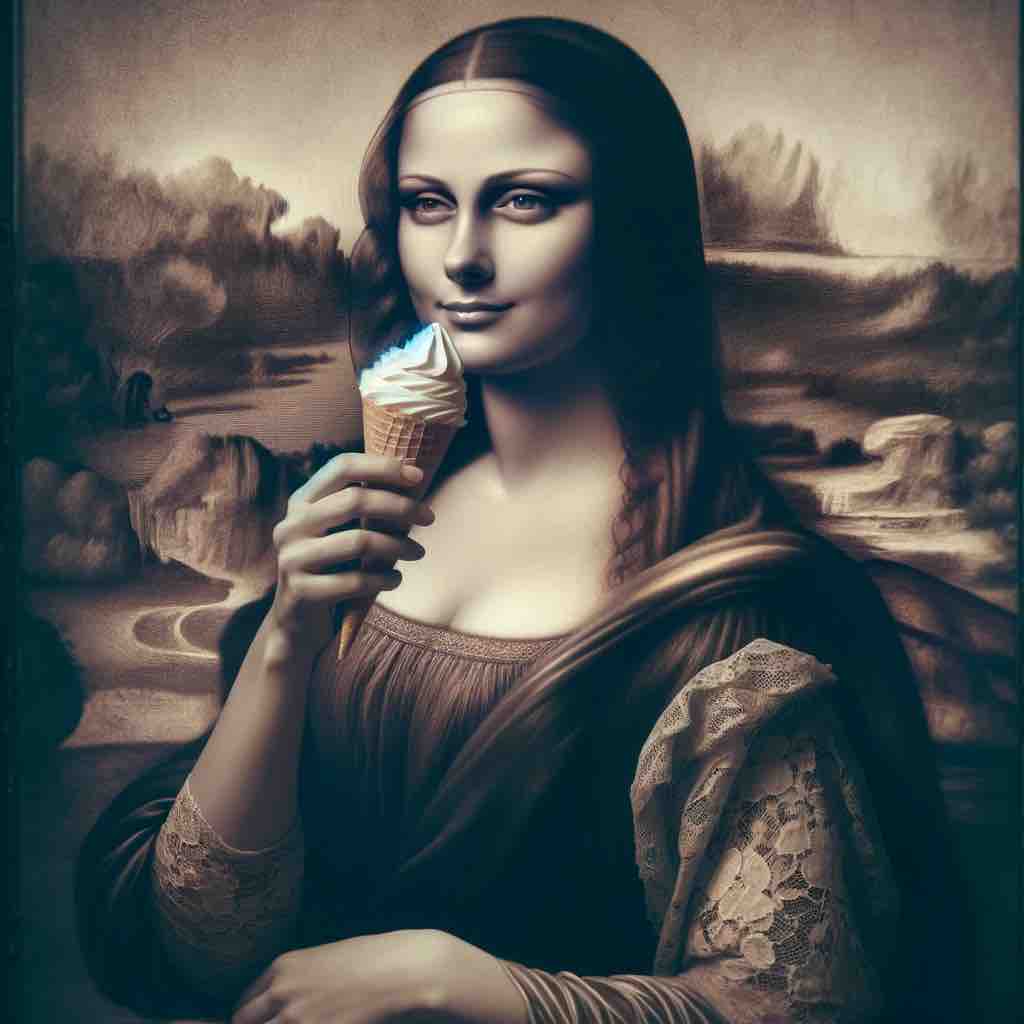
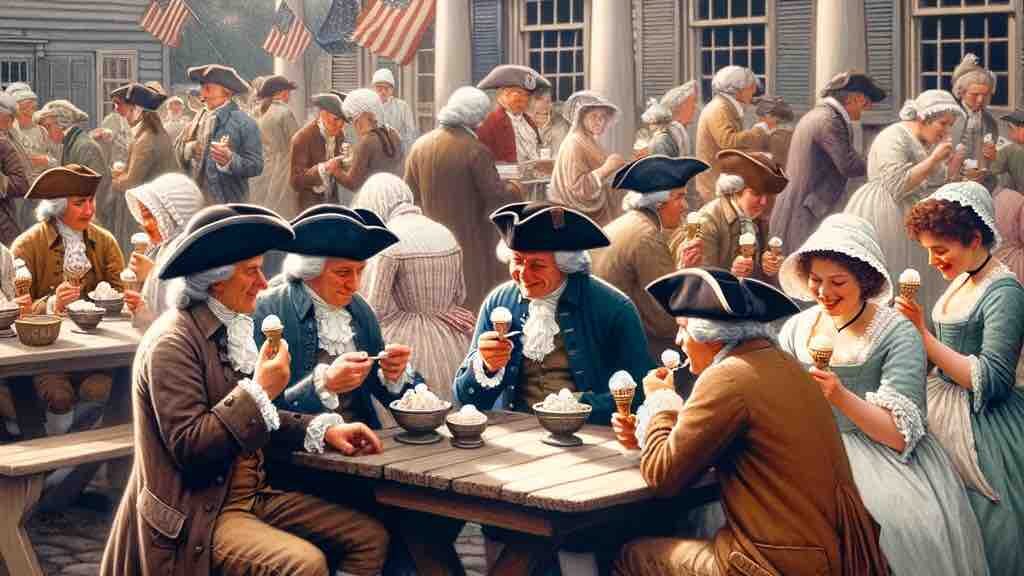
Even American founding fathers George Washington, Thomas Jefferson, and Benjamin Franklin had the pleasure of enjoying this pud and its different flavours.
In the nascent country, cream ice was a sign of freedom and democracy, used to celebrate and commemorate important events such as the Declaration of Independence and the Constitution.
Thomas Jefferson was so fond of this delicious treasure that he penned his own recipe, which begins with the phrase “2 bottles of good cream…”
Ice Cream: The Revolution in Icy Jewels
When Catherine de Medici married Henry II of France in 1533, she brought her Italian culinary heritage. Legend says that it was at her wedding banquet when France knew about the frozen dessert.
Italian confectioner Francesco del Coltelli opened the first ever ice cream parlour in Paris, “Le Procope,” in 1686, and over the next 50 years, the trend spread throughout the city. By the late 17th century, the chilly nectar had become a fashionable delight in France, leading to the opening of numerous shops in the French capital.
Facts
- It takes 5.4 litres of milk to produce 3.7 litres of ice cream
- The average number of lick to finish a scoop of ice cream is 50
- The most popular flavours are vanilla and chocolate
- Americans consume more ice cream than any other country
Gelato
Upon his return from the Far East, Marco Polo brought back not only tales of exotic lands but also the recipe for a frozen milk dessert. In the 16th century, Cosimo Ruggieri created the ‘fior di latte gelato’ for the Medici family, which omitted rice from the mixture. A few years later, Bernardo Buontalenti refined it by using milk, egg yolks, honey, and flavouring with sweet wine and citrus.
Despite its royal beginnings, it was not until the arrival of gelato in Parisian cafes, like “Le Procope,” that it started gaining mass appeal.

Spreading the Knowledge
Thanks to publications in the 18th century, crafting ice cream became more accessible and laid the groundwork for its widespread acceptance. Specialised cookbooks with detailed recipes, such as “The Art of Cookery Made Plain and Easy” by Hannah Glasse in 1751 and “L’Art de Bien Faire les Glaces d’Office” by M. Emy in 1768, opened the gates for people of all social classes to enjoy and create their own treats.
Confectioners and Flavour Exploration
As the popularity of the creamy temptation grew, entrepreneurs like Domenico Negri in London expanded their offerings. By 1789, ice cream recipes had diversified to include a variety of flavours, from fruits to even Parmesan cheese. This period marked the transformation of this frozen sweet from a luxurious rarity to a just-a-click-away pleasure, clearing the way for its global proliferation and the endless variations we enjoy today.
Fact
- British confectioner Philip Lenzi introduced ice cream to America in 1774. He put an ad in the New York Gazette announcing he would make ice cream for everybody.
- The oldest ice cream company in the UK is believed to be “R. Whites Lemonade,” which was founded by Robert and Mary White in 1845
The true revolutionary change came with the mechanisation of the process. For instance, the introduction of the hand-cranked freezer in 1843 by Nancy Johnson and pasteurisation in 1862 by Louis Pasteur improved both the quality and safety of ice cream. The industrial era brought about a significant shift, as steam power and then electric refrigeration enabled mass production, turning the chilled elixir into a staple of public life and enjoyment.
Cultural Impact of Ice Cream and New Creations
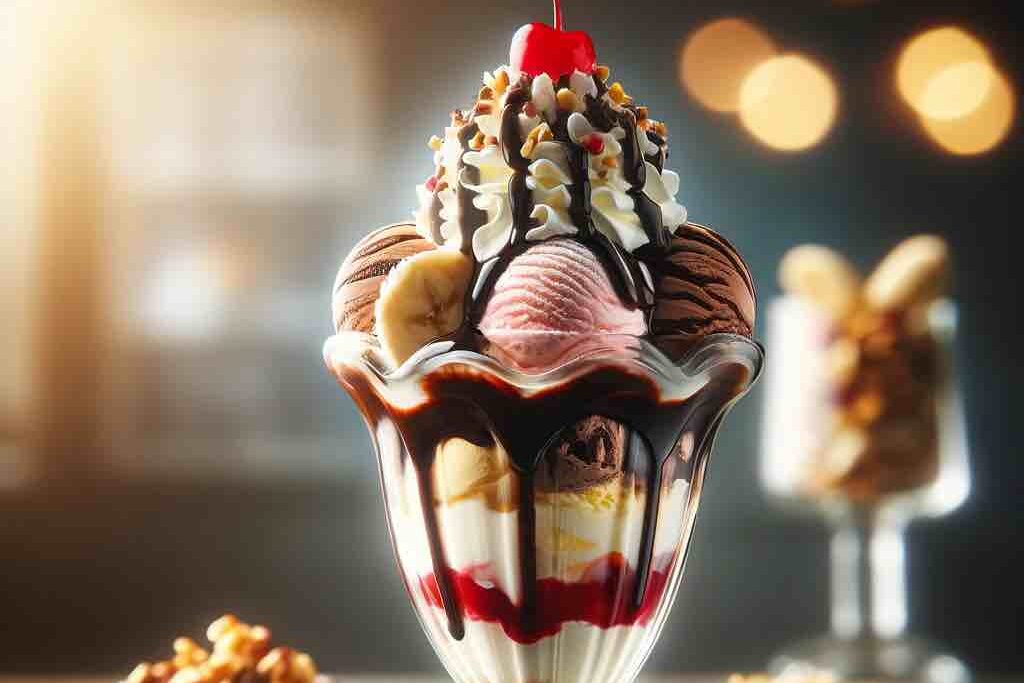
The invention of ice cream soda in 1874 and the debut of the sundae in 1881 showed the influence of this sweet course in US culture.
These novelties became part of the American identity, especially with the sundae being a response to the criticism of consuming ice cream sodas on Sundays.
Fact: America’s oldest ice cream company is Bassetts Ice Cream.
Ice Cream During WWII
Amid World War II, ice cream served as a morale booster for troops, with innovations like the ‘floating ice cream parlours.’ Post-war, the lifting of dairy rationing led to a spike in consumption across the United States and other countries.

“Ice cream brings out the child in all of us.”
Winston Churchill
Modern-day Industry and Trends
During the mid-20th century, traditional parlours decreased as prepackaged ice cream sales in supermarkets gained momentum. Nowadays, specialty creameries and restaurants with unique dishes are back in demand, attracting both nostalgic individuals and a new generation of enthusiasts.
Fact: In 1904, the waffle cone appeared at the world’s fair is St. Louis after an ice cream vendor ran out of bowls.
The revolution of this frozen sunshine from a manually made luxury to a mass-produced staple reflects broader technological advancements and changing social customs, illustrating how a simple frozen dessert can become entwined with cultural identity and innovation.
“Ice cream is the best medium to tell stories. Each flavour is a story of cultures, cuisines, and people.”
Jeni Britton Bauer of Jeni’s Splendid Ice Creams
Scooping Up the Future of Ice Cream
The industry is shaped by consumer preferences for unique, health-conscious, and sustainable options. Artisanal ice cream, known for its craftsmanship and innovative flavours, is taking off with its small-batch, high-quality production.
At the same time, the vegan ice cream market is thriving, thanks to giant strides in food technology that enhance taste and texture using plant-based ingredients. Health-conscious trends are clear with the rise of low-calorie, sugar-free, and functional ingredient-infused ice creams.
Moreover, the industry’s move towards environmental sustainability and ethical practices reflects a growing awareness of global issues. These tendencies not only cater to diverse consumer needs but also signify the sector’s adaptability and innovative spirit.

Frozen Yoghurt
Known as ‘Froyo,’ this innovation emerged as a tart and lower-cal alternative to ice cream. It has a live bacterial culture, which contributes to its tanginess.
Producing frozen yoghurt involves a mix of milk solids, sweeteners, milk fat, yoghurt cultures, and flavourings, which are combined, homogenised, and pasteurised. Air is then added to give it volume and a creamy texture.
This treat is available in various flavours and styles, with alternatives ranging from sugar-free to fat-free and served with a wide array of toppings.
Through the history of ice cream, we’ve seen how it’s evolved and mirrored our cultural, technological, and culinary evolution, becoming a symbol of innovation, indulgence, and joy. Each scoop is a story; each flavour a chapter in this ongoing saga of human ingenuity. As this pudding continues to advance, how will the next generation of frozen symphonies taste? What new stories will they tell? The possibilities, comparable to our appetite for this delightful dessert, are endless.
Before you go, we’d love to hear from you! What’s your favourite ice cream flavour? Share your thoughts and experiences in the comments below. Let’s celebrate the joy together. Happy ice creaming!


